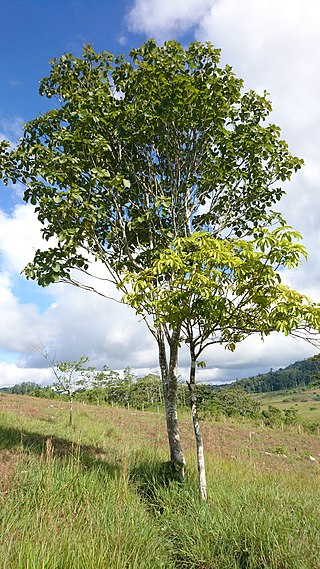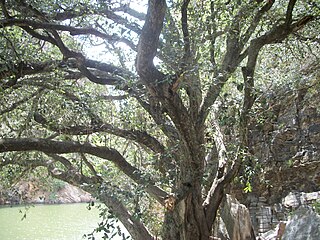
Calliandra is a genus of flowering plants in the pea family, Fabaceae, in the mimosoid clade of the subfamily Caesalpinioideae. It contains about 140 species that are native to tropical and subtropical regions of the Americas.

Chrysobalanaceae is a family of flowering plants, consisting of trees and shrubs in 27 genera and about 700 species of pantropical distribution with a centre of diversity in the Amazon. Some of the species contain silica in their bodies for rigidity and so the mesophyll often has sclerenchymatous idioblasts. The widespread species Chrysobalanus icaco produces a plum-like fruit and the plant is commonly known as the coco plum.
Moquilea fasciculata is a species of plant in the family Chrysobalanaceae. It is endemic to Panama.

Licania is a genus of over 100 species of trees and shrubs in the family Chrysobalanaceae. Species are found naturally occurring in neotropical forests from southern Mexico to Brazil and the Lesser Antilles. Due to increased deforestation and loss of habitat, several species have declined, some markedly so, and L. caldasiana from Colombia appears to have gone extinct in recent years. Many species are either rare or restricted in distribution and therefore potentially threatened with future extinction. In 2016, a new circumscription of Licania was outlined, with over 100 species being placed in other genera such as Moquilea, Leptobalanus, Hymenopus, Microdesmia, Parinariopsis, Geobalanus and Cordillera.
Moquilea chiriquiensis is a species of plant in the family Chrysobalanaceae. It is endemic to Panama. It is threatened by habitat loss.
Hymenopus conferruminatus is a species of plant in the family Chrysobalanaceae. It is endemic to Brazil.
Moquilea longicuspidata is a species of plant in the family Chrysobalanaceae. It is endemic to Ecuador. Its natural habitats are subtropical or tropical moist lowland forests and subtropical or tropical moist montane forests.
Leptobalanus morii is a species of plant in the family Chrysobalanaceae. It is endemic to Panama.

Maranthes is a genus of plant in the family Chrysobalanaceae described as a genus in 1825.

Parinari is a genus of plant in the family Chrysobalanaceae.

Simira is a genus of plants in the family Rubiaceae. The genus was first published by French pharmacist and botanist Jean Baptiste Christophore Fusée Aublet in Hist. Pl. Guiane vol.1 on page 170 in 1775.

Microdesmia rigida, the oiticica, is a species of plant in the family Chrysobalanaceae. It is endemic to Brazil. The oiticica grows deep in floods of rivers and streams, forming long, narrow avenues to the edge of ravines or floodplains staining the dark-green color of its large and dense foliage.
Exellodendron is a genus of plant in the family Chrysobalanaceae described as a genus in 1972.
Angelesia is a genus of flowering plants belonging to the family Chrysobalanaceae.
Gaulettia is a genus of flowering plants belonging to the family Chrysobalanaceae.
Geobalanus is a genus of flowering plants belonging to the family Chrysobalanaceae.
Leptobalanus is a genus of flowering plants belonging to the family Chrysobalanaceae.

Microdesmia is a genus of flowering plants belonging to the family Chrysobalanaceae.
Moquilea is a genus of flowering plants belonging to the family Chrysobalanaceae.





